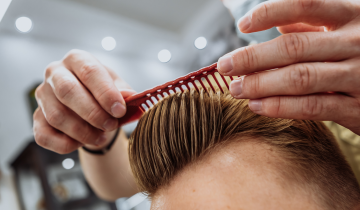HOW TO: GROW YOUR HAIR
Oct 19, 2020 by VTC Dubai
It’s totally normal to become worried once you start to see a few more hairs than normal in your brush. But before you start to panic, we have some good news for you! In many cases of hair loss, it is absolutely possible to regrow hair. Keep reading to learn how to grow hair back.
HOW HAIR GROWS
If you want to understand how to regrow thinning hair, you first need to learn how the hair growth works. Hair grows from the hair follicles on your scalp. Blood vessels nourish your hair follicles with vitamins and nutrients. With proper fuel, the hair follicles create new strands of protein that push outwards from the scalp. Thus, the portion of your hair that is closest to the scalp is only a few weeks or even days old, while the hair at your ends can be several years old.
This process of growth occurs in a series of stages known as the hair growth cycle:
- Anagen – The growth phase when hair cells are the most active. This phase can last between 2 to 6 years.
- Catagen – The transition phase where growth slows down and eventually stops as the hair prepares to shed. 3% of all hair is in this transitional phase at any given time.
- Telogen – The resting phase for the hair follicles. During this time, the old hair rests while a new one begins to grow beneath it. This phase lasts for about three months.
- Exogen – Often called the shedding phase, this is when the old hair detaches and sheds. All hair eventually falls out, and it’s normal and healthy to lose 50 to 100 hairs every day.
While some shedding is an essential part of the hair growth cycle, it’s when you begin to lose more than 100 strands per day that hair loss occurs.

WHY HAIR LOSS HAPPENS
Any interruption to the hair growth cycle can result in thinning hair. At first, it’s pretty easy to find a quick fix and ignore what’s happening, but once you start losing more than 150 hairs per day, confidence in your appearance will likely take a hit.
Before taking any action, take the time to understand what type of hair loss you’re experiencing. Telogen effluvium is a form of temporary hair loss that’s surprisingly common among women. It occurs when a large amount of scalp hairs are forced out of the growth phase. A few months later, more hair than usual sheds.
Telogen effluvium can have many causes, but these are a few of the most common:
- Stress
- Nutritional deficiencies
- Hormonal changes (especially from childbirth or menopause)
- Physical trauma
Luckily, as long as the cause of telogen effluvium is removed, hair will regrow in about six months.
Other forms of hair loss, like androgenic alopecia and traction alopecia, are more permanent. But by seeking treatment and following healthy hair care practices, you can help to mitigate some of the effects.
HOW TO REGROW HAIR
Now that we’ve covered how hair grows and why hair loss happens, let’s talk about how to regrow hair!
1. TRY A SCALP MASSAGE
A simple scalp massage can be a great way to stimulate blood flow to your scalp. Scalp massage improves the delivery of the vitamins and nutrients required for healthy hair growth to the follicles, which may help to grow hair back.
And it’s so easy to incorporate scalp massage into your routine! You can massage your scalp with your fingertips while you are washing your hair in the shower. Or, try a scalp massage with hair-loving essential oils like lavender oil or rosemary oil. Just make sure to do a patch test beforehand to ensure that you’re not allergic to these oils.

2. SUPPLEMENT YOUR DIET
However, no scalp massage will be effective if your diet is missing the ingredients for the optimum hair growth cycle.
If your diet is the issue, look into a existing hair growth* supplement that can provide your hair follicles with all the nutrients they need for regular hair growth. Our pick is Viviscal Advanced Hair Health Supplements, which is formulated with key vitamins and minerals like Biotin, Zinc, Vitamin C, Horsetail Extract, Iron, and Niacin. In clinical studies, women saw a 32% increase in the number of terminal hairs and a nearly 40% decrease in hair shedding in just 3 months.
3. TAKE CARE OF YOUR HAIR
Our next tip is to take care of the hair you do have. Why? Because poor hair care habits lead to breakage, which will make already thinning hair look even thinner. Here’s a few basic pointers:
- Keep your existing hair healthy and strong by washing it with shampoo and conditioner designed for fine or thinning hair, like Viviscal Gorgeous Growth Densifying Shampoo & Conditioner.
- Only use a wide-tooth comb on wet hair, and use a gentle hand whenever you’re detangling.
- Avoid damaging heat tools and too-tight hairstyles whenever possible.
- When you do style your hair with heat tools, always use a general amount of heat protection spray beforehand.
- Finally, keep your hair out of the sun! Just as UV rays can damage your skin, so too can they damage your hair.

4. CONSULT WITH A TRICHOLOGIST
The only way to know whether your hair loss is temporary or more permanent is to visit a trichologist for a consultation. Your trichologist can help you to diagnose the cause and subsequently design a treatment plan for hair growth management.
Remember, the time to act is now. If you notice thinning and hair loss, talk with your doctor about how you can stop hair loss in its tracks and even grow some hair back.



 No products in the cart.
No products in the cart.